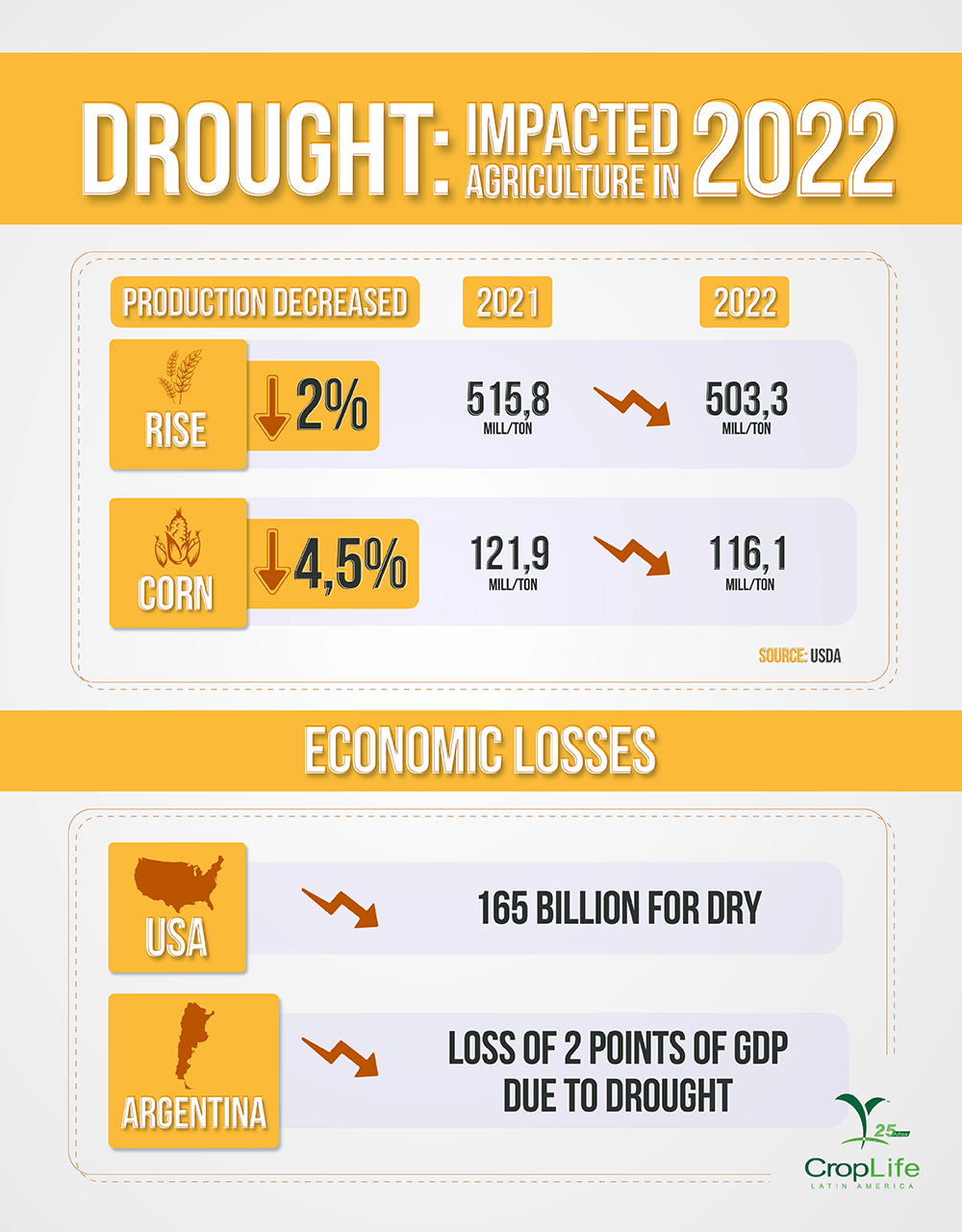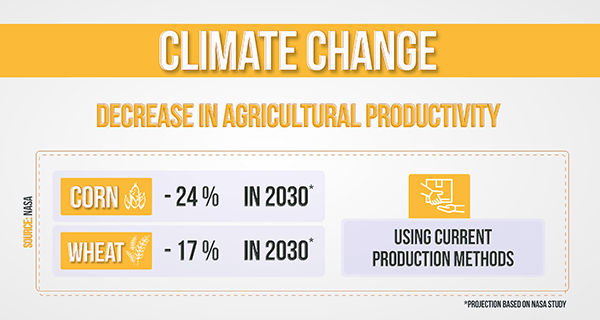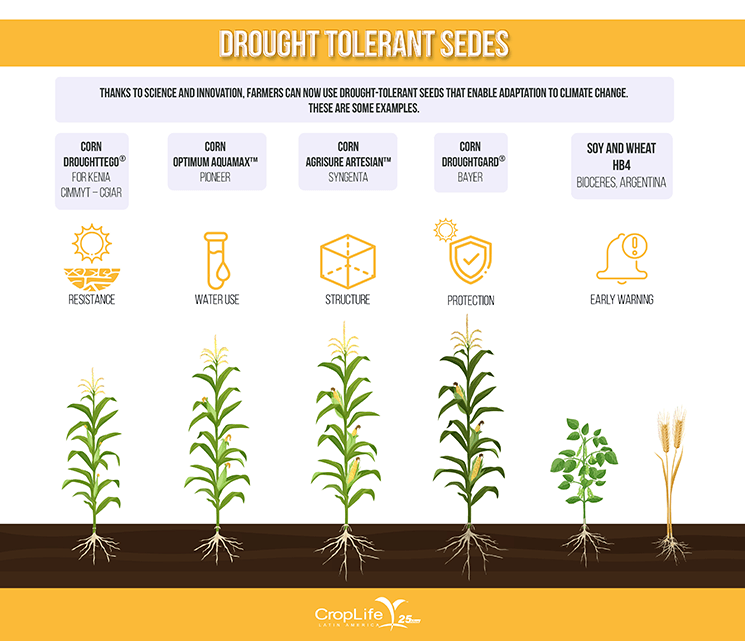Por Alejandro Hernández, PhD
February 2023
Climate change is a reality, the reason for international discussions led by the United Nations1, the Paris Agreement2, the COP27 Climate Change Conference3 and documented by the IPCC4. On agricultural issues, NASA published its crop impact models and predicts a 24% yield decline in corn and 17% in wheat by 2030 using current agricultural production methods5.
In Latin America, IICA is playing a leading role in building bridges for discussion so that agriculture is part of the solution6 . Let's understand a bit about the context and the challenges we will face in just a few years.
1. 2022, lower rice and corn harvests, and perhaps higher in soybeans7

Agriculture had a difficult year in 2022. According to the United States Department of Agriculture, world rice production in 2022 was 503.3 million tons. This is 2% less than the 515.08 of 2021. Global consumption was greater than production, this is 516.9, the balance is possible due to the 15 million tons of the previous year. However, worldwide there is only a reserve of 160.4 million8 . In corn, the situation is similar, with a global decrease of 4.5%, 1,161 million tons versus 1,216.9 MT of the previous year. The United States has a decrease for a total of 348.75 MT versus 382.9 MT of the previous year, which would add to the projected fall of Ukraine for a total of 27 MT versus 42 MT of 2021, as well as Russia of 14 versus 15.23 MT. Corn production in Argentina increased from 49.5 to 52 MT and it also did so in Brazil, which went from 116 to 125 MT. In soybeans, an increase of 10% was estimated, however this could vary due to the drought experienced by Argentina and which extends to the beginning of 2023. Looking to the future, it is important to note that the world's largest importer of soybeans, China, is implementing a policy to achieve self-sufficiency. That policy could change trade in the not-too-distant future. This 2022/23 season, soybean imports from China were higher than the previous one (96 versus 92MT)9 10 , but a gradual decrease is expected until 203011 .
2. Climate change: intensified droughts, floods, and extremes of cold or heat

Drought events are becoming more common. In the United States, losses of 165 billion dollars were recorded in 2022, of which 113 correspond to damages caused by Hurricane Ian and 33 due to drought12 . It is estimated that 2000-2020 was the driest period in the last 800 years, particularly in the West of the country13 and it is impossible to forget the extreme cold cyclonic bomb of December 2022 that affected 60% of the country14 . 2022 caused California to reach historic drought numbers in the last 1,200 years15 , which contrasts with the floods at the beginning of 202316 . Similarly, Portugal17 and Spain18 experienced a great drought; Europe had one of the worst heat waves in mid-2022 with temperatures reaching 40 degrees C19 , while Brazil went from the worst drought in almost a century to floods in 202220 . Australia had its historic millennium drought from 1997-2009 and has just gone through another dry spell from 2017-2019 which prompted the country to import wheat for the first time in 12 years as a result of a 2019 drought21 . In the future, the situation could be even more difficult, not only due to the lack of rain, but also due to the scarcity and/or limited access to water in general22 . Under the current conditions of an agriculture that consumes 69% of the water from rivers, lakes and aquifers, drought phenomena and the constant increase in the use of the resource for irrigation, which is estimated from 2.6 thousand km3 to 2.9 thousand Km3 in 2050, could put in check the food system. Despite this, it is estimated that there would be enough water for agricultural crops, but not for some regions of the world where water will be scarce, such as West and North Africa and South Asia23 .
2022 closed in Chile with a heat wave that caused forest fires24 , and 2023 begins with a report from the Argentine Grain Exchange that calculates that losses due to the drought in agricultural production are almost 2 points of the Gross Domestic Product. The original estimate for soybeans was 49 million MT and it dropped to an estimate of 37 million25.
3. Development of stress-tolerant materials
There are some examples of materials that were developed to deal with climate change and that we detail below. CIMMYT and CGIAR developed DroughtTego maize for Kenya in partnership with the Bill & Melinda Gates Foundation.26 , At a commercial level there are materials such as Pioneer Optimum AQUAmax™, Syngenta Agrisure Artesian™, and Bayer DroughtGard™ (MON-87460-4) that optimize water use27 . The latter has a CspB protein that allows a higher chlorophyll content and better photosynthesis in less leaf area28 .
In soybean and wheat, there are HB4 materials that contain a sunflower transcription factor (the Hahb-4 gene), which functions as an activator of the stress response in the absence of water, which allows it to be less sensitive to ethylene, less senescence, more osmoprotection and maintaining production in the face of drought stress.
Meanwhile, a great challenge in crop improvement is in the development of traits related to stress tolerance, since they are normally independent or specific to the stress. This is how a variety can be resistant to drought, but not necessarily to heat, cold, or floods. Advances in genome editing are encouraging, since they would be recognized as conventional breeding in the very near future, and possibly in the short or medium term, they will allow traits to be stacked on commercial materials. The advance is so promising that the FAO published a publication on its importance in agricultural systems29 . There are genes whose regulation increases stress tolerance at different levels and which could be used to develop more resistant crops in the medium term. For example, an increase in the expression of the gene ARGOS8 (Auxin-Regulated Gene Involved in Organ Size 8) provides tolerance to drought30 . In rice, deleting the OsRR22, STL1 and DST genes, or increasing the expression of MSL37, SNAC2, NAP, P5CS provide tolerance to salinity31. In addition, increased expression of the OsNTL3 gene provides tolerance to heat stress, while increased crop protection mediated by cuticular wax accumulation is achieved when the DHS gene is knocked out.
In the immediate future, we cannot forget good agricultural practices, particularly those related to an increase in soil organic matter.
4. Good agricultural practices
Agriculture can be used as a tool for carbon sequestration and the establishment of vegetation covers. Minimum tillage generates a positive impact since organic matter allows moisture to be captured. This practice is very useful with the use of materials with or without drought tolerance. Soils with a higher content of organic matter and diversity of microorganisms known as microbiome, allow for higher crop yields32 . This can also be achieved by using cover crops in such a way that erosion is prevented and carbon sequestration is increased33 . Legumes and other broad-leaved plants tend to be preferred for this agricultural practice, as well as forage crops34 . One option to evaluate in the near future could be perennial rice, which is a cross of Asian rice (Oryza sativa) with a wild African perennial (Oryza longistamata) that resulted in PR23 rice. This rice can be harvested for several years, with no need for replanting compared to annual rice, although with the difficulty of long-term pest management35.
5. New clues for better crops
An interesting finding this 2022 were three different ways of tolerating drought by tropical plants from their roots. Piper sp does it through compounds that provide structure and defense in the root, Hibiscus rose through fatty acids and antioxidants, while the legume Clitoria is mainly affected by carbon-rich soils that allow the presence of symbiotic microorganisms and therefore nodules in their roots36.
In tomato, under water stress conditions plants respond with an increase in the antioxidant compound lycopene, as well as sugars through starch37.
In Arabidopsis it was discovered that there is an orchestrator of the response to water stress SPEECHLESS (SPCH) directly related to the stomata. The stomata are the places where the plant allows gases such as C02 to enter, but also where it loses water. Arabidopsis uses a stress-related compound, ABA, which inhibits SPCH-mediated stomatal synthesis38.
Without a doubt, we are facing a changing future and it will be key to adapt agricultural production to this new reality, where it is urgent to adapt crops by more expeditious methods, as CIMMYT experts rightly affirm39.

I want permission to use this infographic
Write Us to: comunicaciones@www.croplifela.org
1 United Nations Environment Programme (2022). Emissions Gap Report 2022: The Closing Window — Climate crisis calls for rapid transformation of societies. Nairobi. https://www.unep.org/emissions-gap-report-2022
2 https://www.un.org/es/climatechange/paris-agreement
4 IPCC, 2022: Summary for Policymakers. In: Climate Change 2022: Mitigation of Climate Change. Contribution of Working Group III to the Sixth Assessment Report of the Intergovernmental Panel on Climate Change [P.R. Shukla, J. Skea, R. Slade, A. Al Khourdajie, R. van Diemen, D. McCollum, M. Pathak, S. Some, P. Vyas, R. Fradera, M. Belkacemi, A. Hasija, G. Lisboa, S. Luz, J. Malley, (eds.)]. Cambridge University Press, Cambridge, UK and New York, NY, USA. doi: 10.1017/9781009157926.001.
5 Jägermeyr, J., Müller, C., Ruane, A.C. et al. Climate impacts on global agriculture emerge earlier in new generation of climate and crop models. Nat Food 2, 873–885 (2021). https://doi.org/10.1038/s43016-021-00400-y
6 https://www.iica.int/es/programas/cambio-climatico
7 https://yaleclimateconnections.org/2023/01/the-u-s-had-18-different-billion-dollar-weather-disasters-in-2022/
8 Williams, A.P., Cook, B.I. & Smerdon, J.E. Rapid intensification of the emerging southwestern North American megadrought in 2020–2021. Nat. Clim. Chang. (2022). https://doi.org/10.1038/s41558-022-01290-z
9 https://www.theguardian.com/us-news/2022/dec/24/huge-winter-storm-bomb-cyclone-us-life-threatening-cold-holidays
10 https://www.mercurynews.com/2022/02/14/current-drought-is-worst-in-1200-years-in-california-and-the-american-west-new-study-shows/
11 https://cnnespanol.cnn.com/2023/01/10/fotos-inundaciones-california-enero-2023-trax/
12 Reuters. 2022. Portugal drought worsens, raising fears for crops and water supply. https://www.reuters.com/markets/commodities/portugal-drought-worsens-raising-fears-crops-water-supply-2022-02-21/
13 https://www.france24.com/en/live-news/20220212-spain-portugal-hit-by-winter-drought
14 https://www.bbc.com/mundo/noticias-internacional-62156589
15 https://www.efe.com/efe/america/sociedad/brasil-de-la-peor-sequia-en-casi-un-siglo-a-miles-evacuados-por-las-lluvias/20000013-4733571
16 https://www.theguardian.com/australia-news/2019/may/15/australia-to-import-wheat-for-first-time-in-12-years-as-drought-eats-into-grain-production
17 https://www.wri.org/applications/aqueduct/water-risk-atlas
18 FAO & WWC. Towards a Water and Food Secure Future. White paper 2015, 61.
19 https://www.infobae.com/america/america-latina/2022/12/15/intensa-ola-de-calor-provoca-incendios-forestales-en-la-zona-central-de-chile/
20 https://www.infobae.com/economia/campo/2023/01/12/sequia-estiman-que-ya-se-perdio-el-25-de-la-soja-y-la-cosecha-se-encamina-a-ser-una-de-las-3-peores-de-los-ultimos-15-anos/
21 https://www.cimmyt.org/news/use-of-forecasting-in-agriculture-praised-by-bill-melinda-gates-foundation/
22 Sheoran S, Kaur Y, Kumar S, Shukla S, Rakshit S, Kumar R. Recent Advances for Drought Stress Tolerance in Maize (Zea mays L.): Present Status and Future Prospects. Front Plant Sci. 2022 May 30;13:872566. doi: 10.3389/fpls.2022.872566. PMID: 35707615; PMCID: PMC9189405.
23 Yu, TF., Xu, ZS., Guo, JK. et al. Improved drought tolerance in wheat plants overexpressing a synthetic bacterial cold shock protein gene SeCspA. Sci Rep 7, 44050 (2017). https://doi.org/10.1038/srep44050
24 FAO. 2022. Gene editing and agrifood systems. Rome. https://doi.org/10.4060/cc3579en
25 Shi J, Gao H, Wang H, Lafitte HR, Archibald RL, Yang M et al (2017) ARGOS8 variants generated by CRISPR-Cas9 improve maize grain yield under field drought stress conditions. Plant Biotechnol J 15:207–216. https://doi.org/10.1111/pbi.12603
26 Hernández-Soto, Alejandro et al. 2021. “Rice Breeding in the New Era: Comparison of Useful Agronomic Traits.” Current Plant Biology 27(100211): 100211. https://linkinghub.elsevier.com/retrieve/pii/S2214662821000165.
27 Sokol, N.W., Slessarev, E., Marschmann, G.L. et al. Life and death in the soil microbiome: how ecological processes influence biogeochemistry. Nat Rev Microbiol (2022). https://doi.org/10.1038/s41579-022-00695-z
28 https://www.climatehubs.usda.gov/hubs/northeast/topic/cover-cropping-improve-climate-resilience
29 Komlan Koudahe, Samuel C. Allen, Koffi Djaman. Critical review of the impact of cover crops on soil properties,
International Soil and Water Conservation Research. 2022. 10 (3): 343-354. https://doi.org/10.1016/j.iswcr.2022.03.003.
30 Stokstad, E. ‘Perennial’ rice saves time and money, but comes with risks. Science. 378, (6620):586. 2022. 10.1126/science.adf6990
31 Honeker, Linnea K., Hildebrand, Gina, Fudyma, Jane D., Daber, Erik, Hoyt, David W., Flowers, Sarah E., Gil Loaiza, Juliana, Kuebert, Angelika, Bamberger, Ines, Anderton, Christopher R., Cliff, John B., Leichty, Sarah I., Aminitabrizi, Roya, Kreuzwieser, Juergen, Shi, Lingling, Bai, Xuejuan, Velickovic, Dusan, Dippold, Michaela, Ladd, S. Nemiah, Werner, Christiane, Meredith, Laura, and Tfaily, Malak M.. Elucidating Drought-Tolerance Mechanisms in Plant Roots through 1H NMR Metabolomics in Parallel with MALDI-MS, and NanoSIMS Imaging Techniques. United States: N. p., 2022. Web. doi:10.1021/acs.est.1c06772.
32 Philippe Nicolas, Yoshihito Shinozaki, Adrian Powell, Glenn Philippe, Stephen I Snyder, Kan Bao, Yi Zheng, Yimin Xu, Lance Courtney, Julia Vrebalov, Clare L Casteel, Lukas A Mueller, Zhangjun Fei, James J Giovannoni, Jocelyn K C Rose, Carmen Catalá, Spatiotemporal dynamics of the tomato fruit transcriptome under prolonged water stress, Plant Physiology, Volume 190, Issue 4, December 2022, Pages 2557–2578, https://doi.org/10.1093/plphys/kiac445
33 Yang, X., Gavya S, L., Zhou, Z., Urano, D., & Lau, O. S. (2022). Abscisic acid regulates stomatal production by imprinting a SnRK2 kinase–mediated phosphocode on the master regulator SPEECHLESS. Science Advances, 8(40), eadd2063. https://doi.org/10.1126/sciadv.add2063
34 W. Xiong, M. Reynolds, Y. Xu. Climate change challenges plant breeding Curr Opin Plant Biol (2022), 10.1016/j.pbi.2022.102308
35 United States Department of Agriculture USDA. World Agricultural Supply and Demand Estimates WASDE 632. January 2023. ISSN 1554-9089 https://www.usda.gov/oce/commodity/wasde/wasde0123.pdf
36 Childs, Nathan and Bonnie LeBeau, Rice Outlook: December 2022, RCS-22K, U.S. Department of Agriculture, Economic Research Service, December 13, 2022. https://www.ers.usda.gov/webdocs/outlooks/105473/rcs-22k.pdf?v=5877.2
37 https://www.spglobal.com/commodityinsights/en/market-insights/latest-news/agriculture/122322-chinas-soybean-imports-to-recover-in-2023-on-improved-margins-restocking-needs
38 https://apps.fas.usda.gov/psdonline/circulars/oilseeds.pdf
39 https://www.scmp.com/economy/china-economy/article/3206301/chinas-soybean-imports-have-peaked-and-will-keep-falling-beijing-stresses-food-security-report-says

















